| Please note that these pages are from our old (pre-2010) website; the presentation of these pages may now appear outdated and may not always comply with current accessibility guidelines. |
| Please note that these pages are from our old (pre-2010) website; the presentation of these pages may now appear outdated and may not always comply with current accessibility guidelines. |
GLASGOW UNIVERSITY LIBRARY SPECIAL COLLECTIONS DEPARTMENT
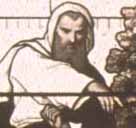
Glasgow
Cathedral Windows
by George Fairfull Smith
|
Click on the images to see them in fuller and more detailed versions
Glasgow University Library’s Special Collections Department has recently acquired an important publication relating to the history of St. Mungo’s Cathedral, the city’s oldest building. The Painted Windows of Glasgow Cathedral (Dougan Add. 106) is a volume containing 43 photographs taken by Thomas Annan, Glasgow’s famous pioneering photographer who is best known for his Old Closes and Streets of Glasgow. The book was published by Annan in the city in 1867, and was dedicated to Queen Victoria and ‘the Noblemen and Gentlemen, Donors of the Painted Windows in Glasgow Cathedral’. It is significant, not only as a fine example of Annan’s use of Joseph Wilson Swan’s permanent carbon process photographs for illustrated publications, but also as a record of the windows which were removed in the 20th century. To the right, a detail fom the Lady Chapel Window is shown. See also images of the windows depicting the Great Prophets, Adam, Noah, Moses, Joshua & Deborah, Saul, Elijah, the Good Samaritan, Jacob and Suffer the little Children. The history of the scheme to fill Glasgow Cathedral windows with painted glass is complex and was extremely controversial, not only in its own time but also today. Glasgow University Library is very fortunate in having manuscript material (MSS Euing 33-43), guidebooks, publications, press cuttings, and ephemera relating to the project which commenced in the 1850s, and was the culmination of the restoration of the city’s greatest medieval building. The library also owns a wide range of books which convey the history of the Cathedral and contain illustrations that reveal how it and its precincts have developed and changed over the centuries. |

Lady Chapel |
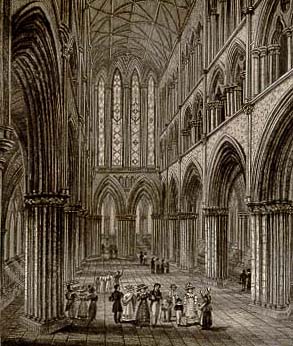
frontispiece: interior of the Choir |
One of the most important illustrated books to be published in Glasgow in the first half of the 19th century was Joseph Swan’s Select Views of Glasgow and its Environs, 1828 (Bh12-a31). The text was written by John M. Leighton, and the illustrations were engraved by Swan after work by Greenock-based John Fleming, Glasgow’s John Knox, and Swan himself. They include Fleming’s ‘View of the interior of the Choir of Glasgow Cathedral from the west’. |
| A few years after the publication of Swan’s views, Archibald McLellan, a coachbuilder, politician, art collector and founder of the civic art collection, and also a subscriber to Swan’s publication, read an essay on the Cathedral at a meeting of the Glasgow Dilettanti Society. McLellan’s Essay on the Cathedral Church of Glasgow, and a history of the See, as connected with the erection of the existing church, with a survey of its present condition and plan for restoration, together with the general improvement of the ancient portion of the city, was published by Brash and Smith in Glasgow in 1833. The work has a few illustrations such as the ‘Grand Western Doorway’, and one copy in the library (Mu23-y24) also has an extra print inserted: John Scott’s ‘Glasgow Cathedral from the Merchants’ Park Cemetery’. His view from the cemetery, which was renamed the Necropolis, shows the Molendinar Burn in the foreground and the Cathedral’s two western towers which were removed in the 1840s as part of the improvements. Scott was an engraver in the city, and drew and engraved the illustrations for John Cullan’s Glasgow Illustrated in a Series of Picturesque Views, 1834. |
| Later publications include the Rev. A. G. Forbes’s Photographs of Glasgow (Mu25-c3) which was published in the 1860s and is illustrated with Thomas Annan’s photographs such as ‘Glasgow Cathedral and the Infirmary’, ‘Glasgow Cathedral and the Necropolis’, and ‘Interior of Glasgow Cathedral’. |
|
Nave looking East |
George Eyre-Todd’s The Book of Glasgow Cathedral, 1898, (Bh11-y2) contains numerous illustrations including photographs and photogravures produced by T.and R. Annan and Sons in Glasgow. They range from the ‘Plan of the lower church’ and ‘Plan of the upper church’, both from lithographs by McFarlane and Erskine of Edinburgh, to Annan’s photograph of the ‘Interior of Blacader’s Aisle’, and two Annan photogravures, the ‘Nave looking east’ (shown to left) and ‘Rood loft’. The ‘Plan of the altars in the Nave and Choir’, includes the High Altar, Holy Cross, St. Mary of Pity, St. Thomas of Canterbury, and St. Kentigern’s. |
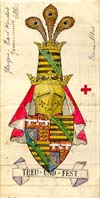
coat of arms for east window |
As mentioned above, the installation of the Cathedral’s windows commenced in the 1850s and much of its history can be traced through the correspondence in Glasgow University Library. Charles Heath Wilson, the headmaster of Glasgow School of Art, supervised the whole scheme and letters from the patrons, designers and artists are preserved along with records of the meetings of subscribers. Some of the volumes also contain watercolours for coats of arms such as those for the east window (MS Euing 41, pp. 71 and 77). |
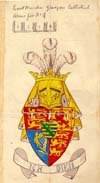
coat of arms for east window |
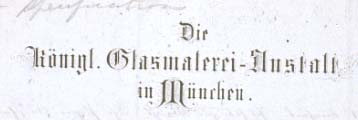
Munich letterhead |
The decision to award the design and manufacture of the major windows to the Royal Bavarian Stained Glass Establishment of Munich (Munich letterhead shown to the left, from MS Euing 36, p.17) was extremely controversial as a number of very influential people including patrons, stained-glass artists and politicians, believed that the commission should have gone to British artists. Glass produced by British, Italian, and other European artists and manufacturers was installed in other parts of the Cathedral and most of it was removed along with the Munich glass in the 20th century. |
| The first window to be erected was ‘The
Resurrection’ which was designed by Professor Hubner of Dresden.
Although it was not photographed by Annan for his book, it is illustrated
in George Eyre-Todd’s The Book of Glasgow Cathedral.
Annan’s publication does record most of the major windows which were gifted by some of Scotland's leading families and individuals, ranging from the aristocracy and gentry to industrialists, and a significant number of women. They included the Duke of Hamilton, Lord Belhaven, Cecilia Douglas of Orbiston, Sir Andrew Orr the Lord Provost of Glasgow, John Tennant of St. Rollox, and William Stirling of Keir who subsequently became Sir William Stirling Maxwell. Most of the ‘Munich Glass’, as well many of the other 19th-century windows, were removed in the 20th century partly because of pollution which caused some of the glass to deteriorate. Recently Historic Scotland has embarked upon a programme of restoring the surviving glass and very generously has agreed to lend some panels to a major exhibition which will examine the life and career of the man who administered the whole scheme. |

Resurrection |
| The exhibition
Charles
Heath Wilson: Missionary for Art was shown at the
Glasgow School of Art
from 22 July to 2 September 2000. For a view of the cathedral today, visit the Glasgow Cathedral website. Text by George Fairfull Smith & web editing by Julie Gardham July 2000 Return to main Exhibitions Page
|